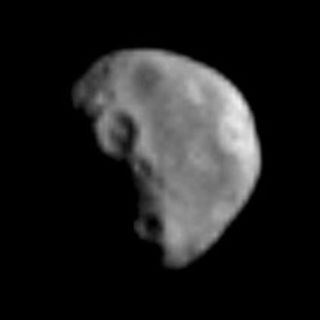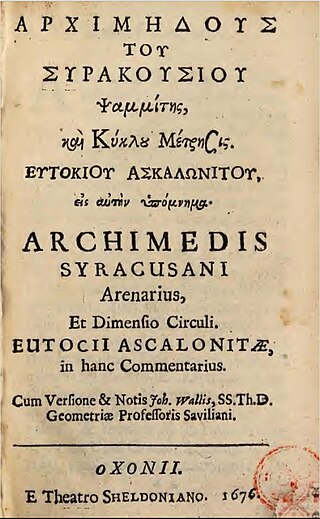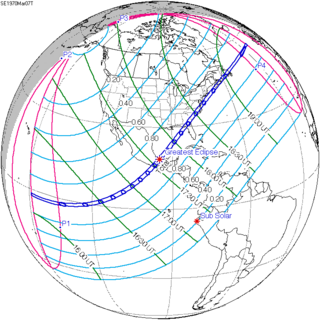Dactylic hexameter is a form of meter or rhythmic scheme frequently used in Ancient Greek and Latin poetry. The scheme of the hexameter is usually as follows :
Hexameter is a metrical line of verses consisting of six feet. It was the standard epic metre in classical Greek and Latin literature, such as in the Iliad, Odyssey and Aeneid. Its use in other genres of composition include Horace's satires, Ovid's Metamorphoses, and the Hymns of Orpheus. According to Greek mythology, hexameter was invented by Phemonoe, daughter of Apollo and the first Pythia of Delphi.
In poetry, metre or meter is the basic rhythmic structure of a verse or lines in verse. Many traditional verse forms prescribe a specific verse metre, or a certain set of metres alternating in a particular order. The study and the actual use of metres and forms of versification are both known as prosody.

Ida, minor planet designation 243 Ida, is an asteroid in the Koronis family of the asteroid belt. It was discovered on 29 September 1884 by Austrian astronomer Johann Palisa at Vienna Observatory and named after a nymph from Greek mythology. Later telescopic observations categorized Ida as an S-type asteroid, the most numerous type in the inner asteroid belt. On 28 August 1993, Ida was visited by the uncrewed Galileo spacecraft while en route to Jupiter. It was the second asteroid visited by a spacecraft and the first found to have a natural satellite.

A natural satellite is, in the most common usage, an astronomical body that orbits a planet, dwarf planet, or small Solar System body. Natural satellites are colloquially referred to as moons, a derivation from the Moon of Earth.

(243) Ida I Dactyl is a tiny asteroid moon that orbits asteroid 243 Ida. It was imaged by the Galileo spacecraft on August 28, 1993; Dactyl was discovered while examining the delayed image downloads from Galileo on February 17, 1994. It was provisionally designated S/1993 (243) 1. The satellite was named after the mythical creatures called dactyls who lived on Mount Ida according to Greek mythology.
A spondee is a metrical foot consisting of two long syllables, as determined by syllable weight in classical meters, or two stressed syllables in modern meters. The word comes from the Greek σπονδή, spondḗ, 'libation'.

The Sand Reckoner is a work by Archimedes, an Ancient Greek mathematician of the 3rd century BC, in which he set out to determine an upper bound for the number of grains of sand that fit into the universe. In order to do this, Archimedes had to estimate the size of the universe according to the contemporary model, and invent a way to talk about extremely large numbers.
(45) Eugenia I Petit-Prince is the larger, outer moon of asteroid 45 Eugenia. It was discovered in 1998 by astronomers at the Canada-France-Hawaii Telescope on Mauna Kea, Hawaii. Initially, it received the provisional designation S/1998 (45) 1. Petit-Prince was the first asteroid moon to be discovered with a ground-based telescope. Previously, the only known moon of an asteroid was Dactyl, discovered by the Galileo space probe, around 243 Ida.
This is a directory of lists of geological features on planets excepting Earth, moons and asteroids ordered by increasing distance from the Sun.
In Greek mythology, the Dactyls or Daktyloi were the archaic mythical race of male beings associated with the Great Mother, whether as Cybele or Rhea. Their numbers vary, but often they were ten spirit-men so like the three Korybantes or the Cabeiri that they were often interchangeable. The Dactyls were both ancient smiths and healing magicians. In some myths, they are in Hephaestus' employ, and they taught metalworking, mathematics, and the alphabet to humans.

A dactyl is a foot in poetic meter. In quantitative verse, often used in Greek or Latin, a dactyl is a long syllable followed by two short syllables, as determined by syllable weight. The best-known use of dactylic verse is in the epics attributed to the Greek poet Homer, the Iliad and the Odyssey. In accentual verse, often used in English, a dactyl is a stressed syllable followed by two unstressed syllables—the opposite is the anapaest.

Jona Lewie is an English singer-songwriter and multi-instrumentalist, best known for his 1980 UK hits "You'll Always Find Me in the Kitchen at Parties" and "Stop the Cavalry".

The Hiten spacecraft, given the English name Celestial Maiden and known before launch as MUSES-A, part of the MUSES Program, was built by the Institute of Space and Astronautical Science of Japan and launched on January 24, 1990. It was Japan's first lunar probe, the first robotic lunar probe since the Soviet Union's Luna 24 in 1976, and the first lunar probe launched by a country other than the Soviet Union or the United States. The spacecraft was named after flying heavenly beings in Buddhism.

The Koronis or Koronian family, also known as the Lacrimosa family, is a very large asteroid family of stony asteroids, located in the outer region of the asteroid belt. They are thought to have been formed at least two billion years ago in a catastrophic collision between two larger bodies. The family is named after 158 Koronis, and the largest known member is about 41 km (25 mi) in diameter. The Koronis family travels in a cluster along the same orbit. It has 5949 members.

The Lac Wiyâshâkimî, also called the Clearwater Lakes in English and Allait Qasigialingat by the Inuit, are a pair of annular lakes and possible impact craters on the Canadian Shield in Quebec, Canada, near Hudson Bay.

A total solar eclipse occurred on March 7, 1970, visible across most of North America and Central America.
Dactylic metre is any meter primarily composed of dactyls. It may refer to:
Latin prosody is the study of Latin poetry and its laws of meter. The following article provides an overview of those laws as practised by Latin poets in the late Roman Republic and early Roman Empire, with verses by Catullus, Horace, Virgil and Ovid as models. Except for the early Saturnian poetry, which may have been accentual, Latin poets borrowed all their verse forms from the Greeks, despite significant differences between the two languages.









